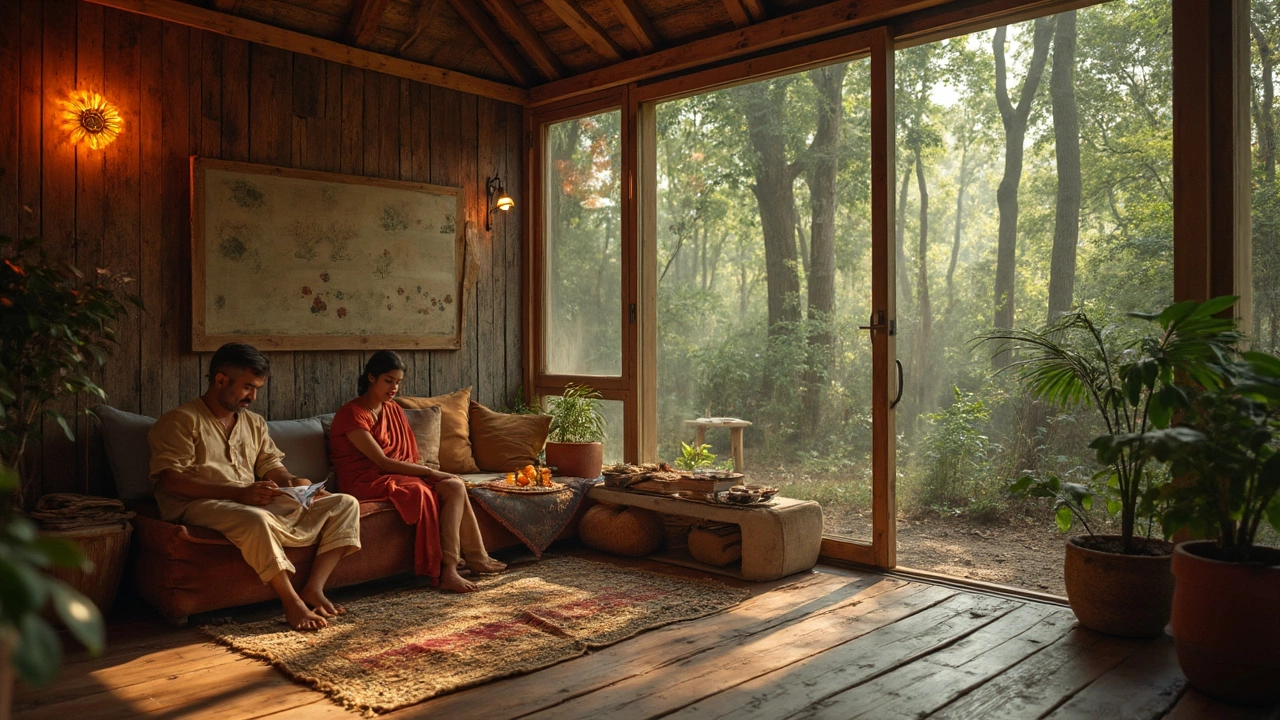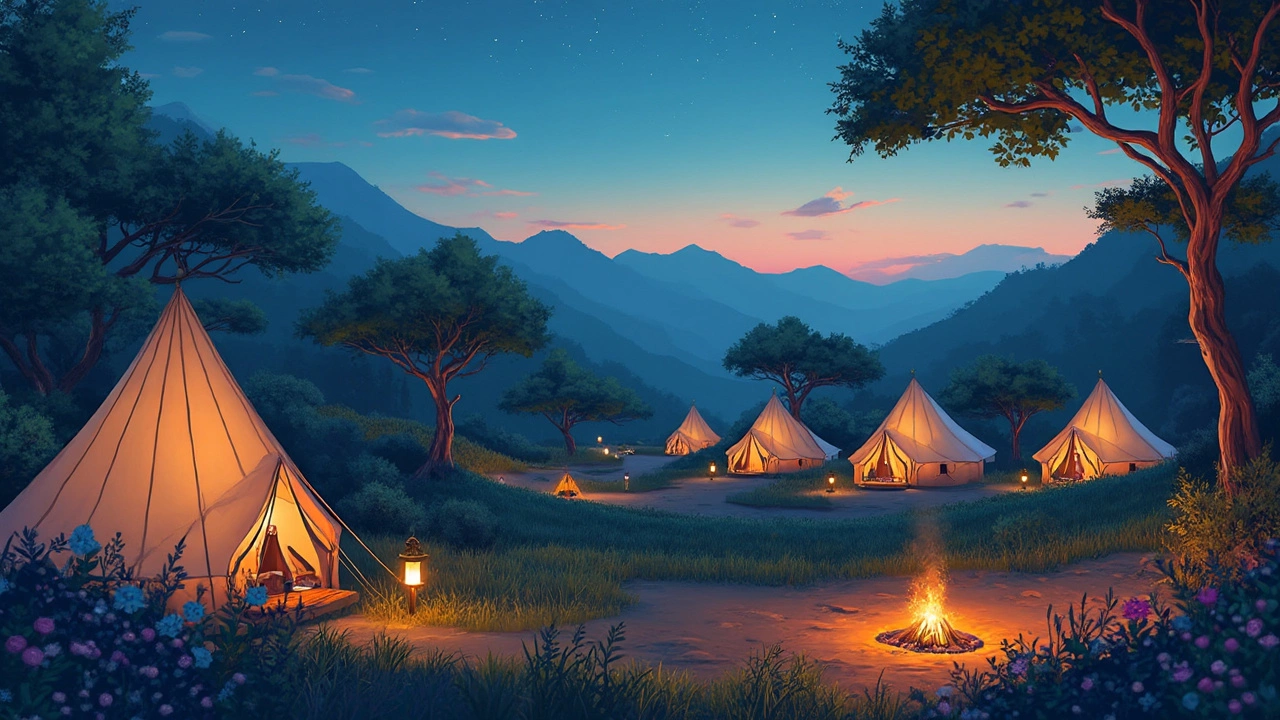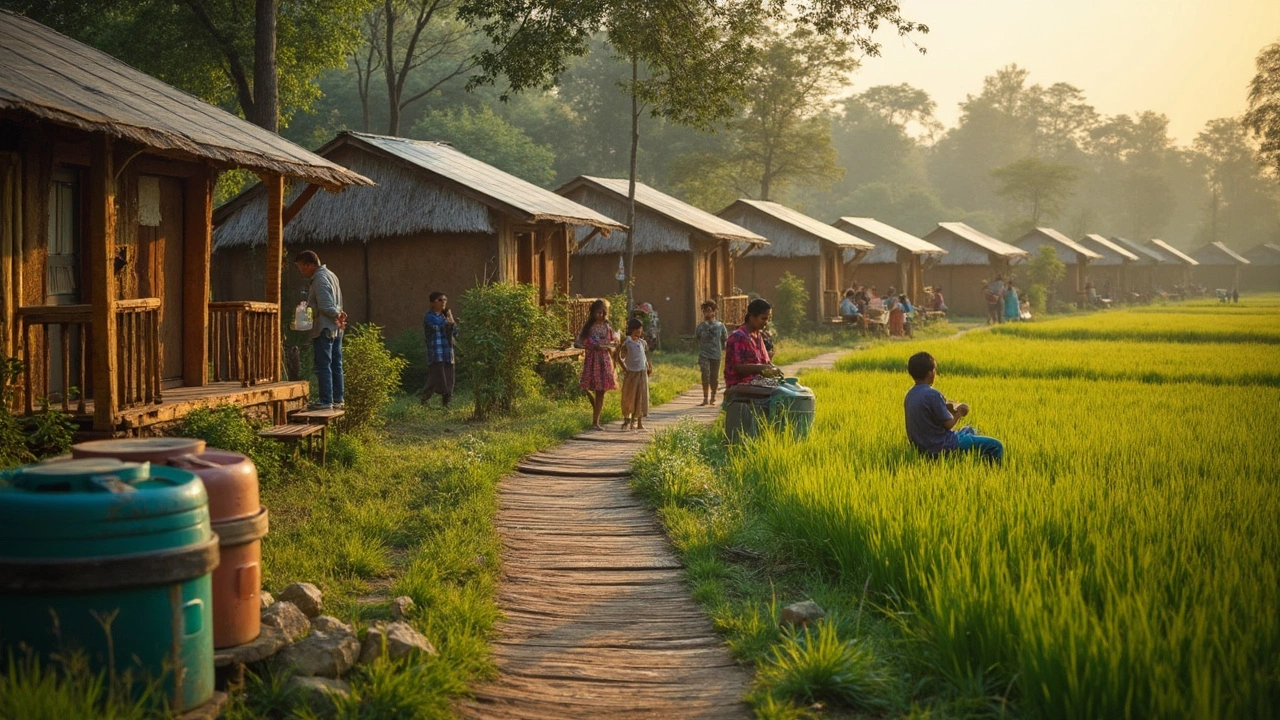Most folks think eco-friendly travel means roughing it. Truth is, glamping flips that idea on its head. You still get comfort—think real beds, proper bathrooms, and hot showers—but with your carbon footprint trimmed way down. How? It’s baked right into the way these cottages and tents are set up, using way less energy and water than a big hotel.
Look around a proper glamping site and you’ll spot solar panels on rooftops, rain barrels tucked behind cabins, even composting toilets that barely touch the local environment. The places are often built off-grid, using clever design tweaks so they blend in without bulldozing nature. These things sound small, but stack them up, and you’ve got a holiday that feels good in every sense.
Anybody can book a swanky hotel with a giant pool, but if you care about making choices that matter, glamping is a smart move. And it’s not just for hippies—plenty of families, couples, and friends who like their creature comforts are making the switch. So what should you keep an eye out for when planning your green escape? Let’s dig into what actually makes this kind of vacation less wasteful and a lot more thoughtful.
- What Makes Glamping Green?
- Low-Impact Design and Building Materials
- Saving Energy and Water
- Waste: How Glamping Cuts Down
- Tips for an Even Greener Glamping Experience
What Makes Glamping Green?
So why is glamping suddenly such a big deal for eco-friendly travel? The real answer is in the simple choices these spots make right from the start. Most glamping and eco-friendly cottages are designed to leave a tiny footprint. That means minimal land disturbance, using materials like recycled wood, and often popping up on sites that would otherwise sit empty or be cleared for something less nature-friendly.
Unlike big hotels or resorts that can chew up a lot of local resources, glamping setups pull the brakes. They skip the sprawling lawns that need loads of water, and you won’t find stuff like energy-wasting elevators or huge air conditioners running 24/7. Many glamping cottages are now built off-grid, with solar panels powering lights or water heaters. That means less power from fossil fuels, which is a win for everyone.
“Staying at an eco camp or green cottage can cut your energy use and water waste by up to 60% compared to a standard hotel,” says the folks at EcoStay Foundation.
This isn’t just about buildings, either. Sustainable travel these days means more than just tossing your cans in the recycling. A lot of glamping places use local food, source supplies nearby, and build trails or outdoor spaces that are meant to last—not wreck the landscape. It’s all about staying comfortable without trashing the planet.
- Minimal land clearing reduces disruption to wildlife.
- Off-grid power—think solar and batteries—brings down emissions.
- Eco-friendly cleaning supplies help keep water sources clean.
- Low-flow water fixtures slash water use.
- Using local materials supports nearby communities and keeps carbon footprints small.
Check out the numbers below for a clearer picture:
| Type of Stay | Avg. Daily Water Use (liters) | Avg. Daily Energy Use (kWh) |
|---|---|---|
| Glamping Cottage | 70 | 8 |
| Standard Hotel | 180 | 22 |
So if you’re aiming for a trip that’s easy on nature, glamping is one of the smartest calls out there. The changes they make may sound simple but stack up to something big when a lot of us get on board.
Low-Impact Design and Building Materials
When you step into a proper glamping cottage, it’s not about flashy details or show-off architecture. It’s all about blending in and leaving as little mark as possible. The best glamping sites use eco-friendly cottages made from stuff that’s easy on the planet: think locally sourced timber, recycled metal, or even reclaimed barn wood. Not only does this mean fewer trucks shipping materials from miles away, but it also gives buildings a natural look that fits into the landscape instead of fighting it.
Most glamping businesses are picking suppliers who care about the earth, too. For example, there are places in Cornwall using sheep’s wool for insulation, so you get warmth without needing heavy heating. Tiny homes and yurts often sit on raised decks instead of concrete slabs. That keeps the ground underneath healthy, meaning no massive land scraping or soil poisoning. Some outfits skip poured foundations entirely—unpack in spring, pack up in fall, and nature hardly noticed you were there.
Here’s a breakdown of common features used in low-impact glamping builds:
- Recycled and repurposed building materials
- Renewable insulation (sheep wool, hemp, recycled denim)
- Non-toxic paints and finishes
- Modular or portable designs for seasonal use
- Structures that work with the existing terrain, not against it
According to a 2023 report by EcoStay Solutions, around 60% of new eco-friendly cottage builds avoid concrete altogether and opt for timber frames or platforms. That slashes CO2 output and helps local wildlife stay put. Here’s a quick look at how different methods stack up:
| Material/Design | CO2 Footprint | Impact on Land |
|---|---|---|
| Concrete Foundations | High | Disruptive |
| Timber Decking | Low | Minimal |
| Recycled Materials | Very Low | Minimal |
One expert, Liz Clark from Green Holidays Association, summed it up best:
“You can’t call a getaway green if you’re pouring tons of concrete or importing exotic wood. The smartest glamping sites work with the land and use what’s already close by.”
This all adds up to less land damage and lower emissions, making glamping with eco-friendly cottages a solid choice for anyone trying to travel lighter on the earth.

Saving Energy and Water
Here’s something most people don’t realize: a typical hotel uses 50% more energy per guest than a small eco-friendly cottage or glamping site. That’s a huge gap. Glamping setups focus on the basics—lights, heating, and showers—but tackle them in smarter, low-energy ways.
The big move? Swapping out grid power for solar. Many popular glamping spots have solar panels that charge batteries during the day. These run the essentials at night without burning fossil fuels. Some have backup generators that only fire up when needed (rarely). Want to charge your phone? You’ll usually find solar-powered outlets right inside your tent or cabin, keeping things simple and green.
Heating and cooling? Forget huge AC units. Well-insulated walls, ventilated designs, and sometimes wood stoves heat things up or cool things down with way less energy. Some places demo cool tricks, like using thick canvas or living roofs that naturally keep temperatures nice without any electricity at all.
Water’s another hot topic in sustainable travel. Glamping sites often collect rainwater in tanks or barrels. That gets filtered and piped into your bathroom and kitchen—no need to tap into city water lines. Low-flow showers and composting toilets cut water waste even more. The average glamping shower uses as little as 4 gallons of water, compared to a hotel’s 10-12 gallons per shower.
Check out these quick comparisons between glamping and traditional stays:
| Feature | Glamping | Traditional Hotel |
|---|---|---|
| Energy Source | Solar/Off-grid | Main grid/fossil fuels |
| Water Usage (Shower) | 4 gallons | 10-12 gallons |
| Heating/Cooling | Insulation, wood stoves, passive cooling | Central air conditioning/heating |
If you want to use less energy and water on your next trip, look for eco-friendly cottages with solar panels, rainwater tanks, and low-flow fixtures. Every small tweak adds up. You get your comforts—hot water, lights, a warm bed—without the guilt trip.
Waste: How Glamping Cuts Down
Traditional hotels churn out a lot of waste—think single-use toiletries, daily towel swaps, and piles of plastic water bottles. Glamping, especially when you’re in eco-friendly cottages or tents, does things differently by cutting those habits right out.
Most glamping sites ditch those tiny single-use soaps for refillable pump bottles. You’ll find compost bins and clearly marked recycling stations, making it easy to keep stuff out of landfills. And instead of swapping out towels every day like a hotel, you’ll be encouraged to reuse them—saves water and slashes laundry waste.
Many glamping outfits also use kitchen setups with real plates and cutlery, not plastic forks and cups. That change alone seriously shrinks the pile of trash at camp. And a bunch of sites have started using composting toilets, which turn waste back into useful, safe material for the environment, instead of filling up a septic tank or city sewer system.
- Sustainable supplies: Bulk dispensers for shampoo and soap—no more wasteful packets.
- Less food waste: Many places encourage guests to compost leftovers and even grow their own herbs on-site.
- Minimal packaging: Hosts often buy supplies in bulk or choose reusable containers for stuff like coffee, sugar, or snacks.
To show what kind of impact this has, here’s how glamping stacks up against the hotel industry on waste:
| Type | Average Daily Waste per Guest |
|---|---|
| Typical Hotel | 1.7 kg |
| Eco-Friendly Glamping Site | 0.5 kg |
That’s a huge difference. So the next time you zip up your glamping tent or unlock your eco-friendly cottage, remember: you’re leaving a lighter mark by simply making smarter, less wasteful choices.

Tips for an Even Greener Glamping Experience
Want to get the most eco-friendly bang for your buck while glamping? These tips make a real difference, whether you’re staying in eco-friendly cottages or a fancy safari tent. With just a bit of thought, anyone can help keep the footprint small—while still having a blast.
- Pick the right site: Look for glamping places that have certified green credentials—like Green Key, LEED, or local eco-certifications. These badges mean a site lives up to real environmental standards, not just empty promises.
- Pack reusable gear: Bring your own water bottle, coffee cup, and food containers, so you skip the single-use plastics. Many glamping spots have spots for filling bottles straight from safe, filtered water supplies.
- Support local: Buy groceries from nearby markets or get meals at local cafes. This cuts food miles, backs the local economy, and often means tastier, fresher eats. Some glampsites even partner with nearby farms for farm-to-table meals.
- Respect wildlife: Keep to marked trails, don’t feed the animals, and leave the wildflowers where they are. Messing with nature does more harm than most folks realize.
- Be mindful of power and water: Even if you’re in a place with solar panels, don’t leave lights on or let taps run. Every bit helps, especially in off-grid spots.
If you want to see how much water and energy you can save compared to a typical hotel stay, check out these numbers—real eye-openers:
| Feature | Glamping Cottage (per guest, per night) | Standard Hotel (per guest, per night) |
|---|---|---|
| Water Use | 40–60 liters | 150–300 liters |
| Electricity Use | 1–3 kWh | 6–12 kWh |
| Waste Generated | ~0.2 kg | ~1 kg |
Not every site will be perfect, but if everyone pitches in and thinks about their habits, it adds up fast. You totally don’t have to give up comfort or fun to help the planet—a few smart choices do the job.
